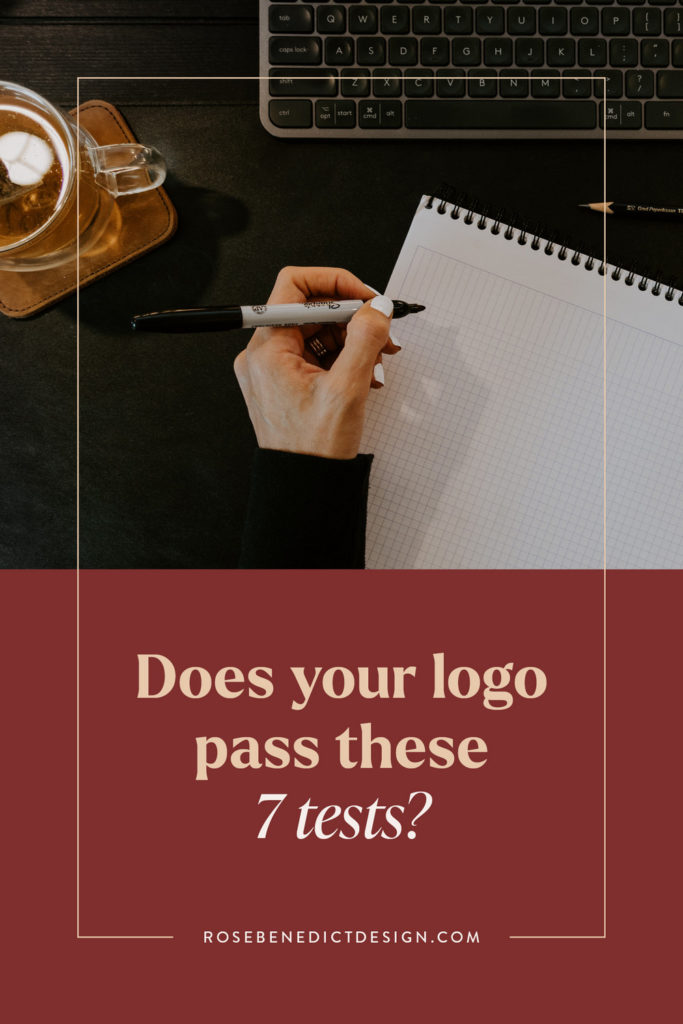Does Your Logo Pass These 7 Tests?
February 1, 2022
I’ve been in the branding and graphic design world for over eight years now, and I’ve seen (and designed!) a lot of logos. One of the things that will help you improve your brand’s presence online is a strong understanding of whether your logo is professional or not. Your dream client is out there, and we want to make sure that they know quickly and easily that your business is here to serve them! So if you’re curious whether your logo passes these tests or not, read on:
Test #1: Legibility
This might be a no-brainer, but it’s pretty common to see logos using extreme fonts, stretched or indistinguishable letters, or illegible scripts, resulting in the logo being difficult to read. A top problem in this category would be using a font with way too high of contrast or very thin lines, resulting in something very hard to read when the logo is smaller or placed on certain backgrounds. Make sure that when you are making decisions on what your logo will look like, you show it to a few trusted people in your life who can be honest about any legibility issues, saving you from a redesign!
Test #2: Scalability
The primary job of a logo is to be an identifier of your business, but what if someone can’t read it sometimes? This is obviously very bad news, as all well-designed logos (or logo variations) will be scalable to sometimes very large or very small settings. If you can barely read your logo in certain situations, it’s probably time to adjust the logo, add logo variations for smaller settings, or completely redesign it.
Test #3: Black & White
When I was in design school, this was aptly named the “black-and-white” test. Does your logo still work when it’s adjusted to being one single color? This is important because your logo will be applied to many different pieces of marketing collateral and/or promotional items, and if you skip this step, printing (especially for t-shirts) could become really expensive or produce not-so-great results.
Test #4: Availability
Does your logo design exist already? It’s astonishing how many people skip this very important step, because you’d want to avoid a potential cease and desist letter at all costs! You can do a reverse image search on Google as a great first step, search the U.S. Patent Office, or consult an attorney to see if your logo is already taken. The exact steps that you take to pass this test will likely depend on the size of your business. Small businesses might do the former step, but medium to larger businesses should definitely take the extra step to consult an attorney who specializes in this area.
Test #5: Simplicity
Simplicity is a huge contributor to recognizability. There’s a reason so many clients mention how much they like Apple’s logo and the Nike swoosh. Their simplicity and recognizability make them attractive and successful. There are some exceptions to this rule, but generally if your logo is overly complicated, or looks more like a detailed illustration than a logo, it’s probably time to rethink it, or at least distill it down only to its essential parts.
Test #6: Versatility
A lot of small business owners may not know this, but versatility is an important part of the overall logo design that contributes to a more professional look. If only one logo orientation is designed, this creates future problems in a number of ways. What do you use as your social media profile photo, or your favicon (browser tab icon)? An experienced brand designer will create multiple versions of your logo to solve these problems. For example, they may create your main (or preferred) logo, your secondary logo (for tight spaces), a submark (often used for website footers and social media), and a favicon to make sure that you’re squared away in this area.
Test #7: Tailored
Does your ideal client brew their own beer on the weekends, have an Etsy side hustle, or dream of one day being a beekeeper? In that case, a logo with an artisanal, crafty, or rustic style may appeal to them and help them understand that you are speaking to them. If your logo strays too far from who your ideal client is, it won’t say to them, “Hey! I’m here for you!” And we want your clients to know from the first second that you are here for them. So give yourself a “style audit” and think not just about what you like, but about what your ideal client likes.
If your logo passes all seven of these tests, congrats! You’ve passed with flying colors (and maybe those colors are in your brand’s color palette?!). If your logo doesn’t pass, maybe it’s time to contact a brand designer to figure out a better strategy for your brand moving forward. I’m here to help, and feel free to let me know below if this was helpful for you!

About the Author:
Rose Benedict
Owner and Designer, Rose Benedict Design
Rose Benedict is a brand and website designer for therapists, creatives, artists, and service providers. Rose is also a Showit Design Partner and the owner/designer at Rose Benedict Design. She has been a designer for the past 10 years and has worked at a Fortune 15 company and top university in Columbus, Ohio. She brings both her brand/website design and technical experience to small business owners so that they can thrive and deeply connect with their ideal clients. Outside of work, Rose loves reading, pilates, gardening, and traveling (10 countries and counting!).
Rose Benedict Design is a brand and Showit web designer based in Columbus, Ohio, devoted to crafting beautiful, strategic brands for creatives and service providers.
©2022-2024 ROSE BENEDICT DESIGN
Rose Benedict Design is a proud Showit Design Partner.
